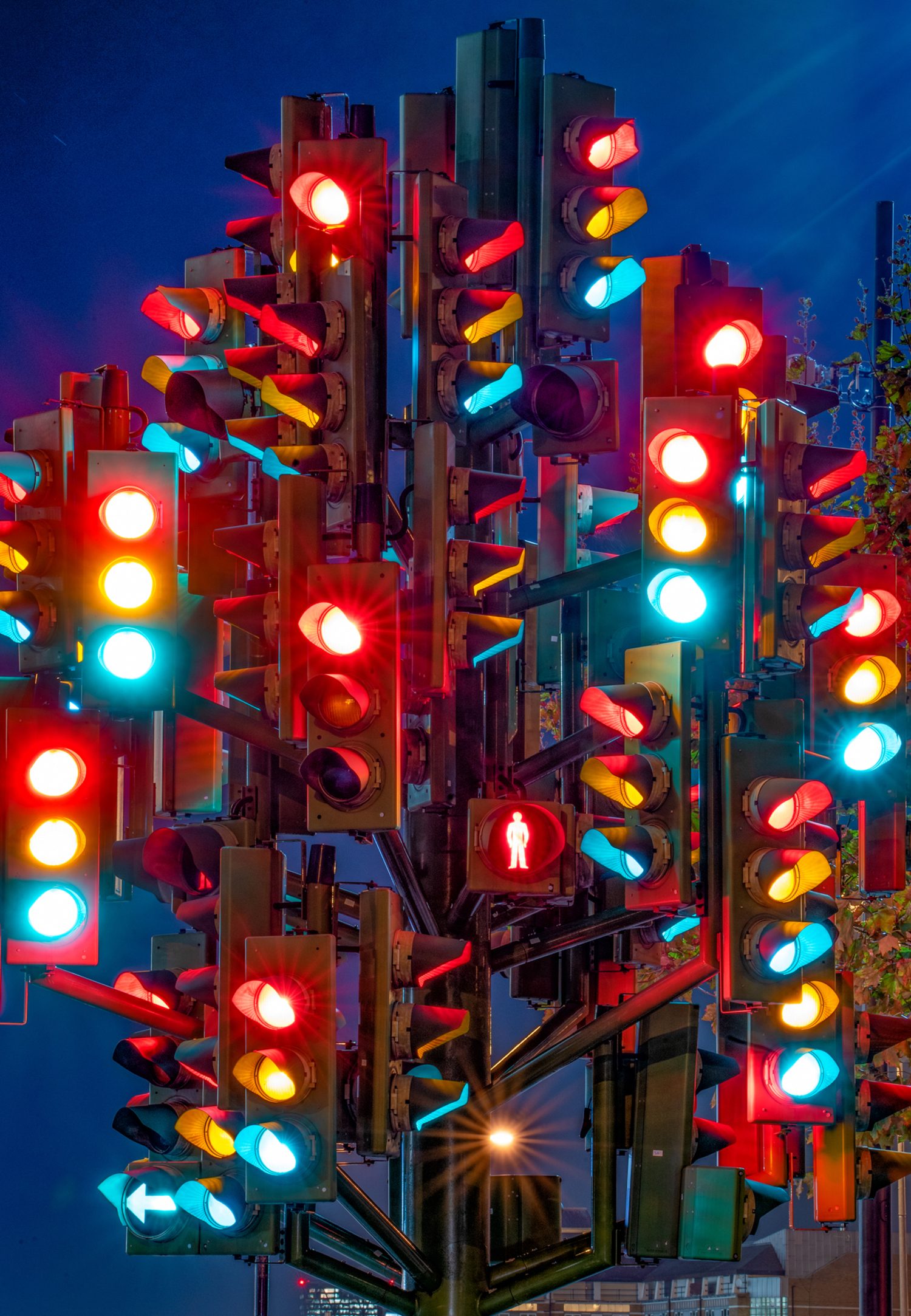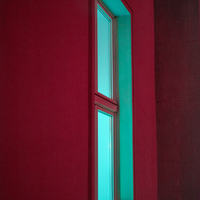The subject of alienation is often found at the heart of Italian photographer Cristiano Volk’s work. In his 2019 publication Sinking Stone, for instance, the 33-year-old tackled the disconnected experience of travel and tourism in the ever-decaying city of Venice, while in his 2020 photobook Mélaina Cholé, he mined the nature of depression through images of planet earth as seen from space. His subjects may take diverse and meandering routes, but the human experience is always key. His latest project, Laissez-Faire, is no exception.
Described by Volk as “a single, neon-hued hallucination”, Laissez-Faire is a richly researched meditation on ideas of capitalism and commodity culture. In it, the artist collapses the usual parameters that shape our worldly existences—day and night, inside and outside, public and private, digital and real—into a feverishly imagined new universe; one where individuals no longer experience reality directly, but live their entire lives behind screens instead. It’s a scary prospect, he says, but one that is ebbing closer to our collective existence now than we’d ever like to admit.
Here, Volk talks to Joanna L. Cresswell for LensCulture about finding the perfect balance between dream and nightmare, the modernist impulses behind his work, and exploring what skyscrapers and discos have in common.

Joanna Cresswell: Tell us about your early life to set the scene. Where did you grow up and how did that environment shape you?
Cristiano Volk: I grew up in a small town in Italy called Staranzano and I basically spent my first 25 years there. I have beautiful memories of my childhood and I’m very lucky because I have always had my grandparents, my parents and my sister by my side who have given me a lot of affection.
JC: And what was your journey into photography and the kind of work you make now?
CV: When I was about 20 years old, together with a dear friend named Stefan, I developed a passion for music, cinema and literature. It was a very busy time and I remember watching a movie every day. From there, the step towards photography was rather immediate. And I arrived at the type of work I create with a specific language, thanks to my two teachers Massimo Mastrorillo and Federico Clavarino. They trained me, and influenced my way of approaching photography, as did the many authors I studied (some of whom I collaborated with through various workshops).

JC: What’s the story behind your project Laissez-Faire? What inspired it and when did it begin?
CV: Laissez-Faire began in January 2018. It is a photographic journey that tells the story of today’s society, through the eyes of an investigative lens. In it, I reveal hidden worlds of transgression, and explore how as a society, we are often led to desire what is only on the surface of things. My previous project was carried out entirely in the city of Venice for about a year, so for Laissez-Faire, I felt the need to travel, and set off to various countries around the world such as the United Arab Emirates, the United States, France, Germany, Austria, England, the Czech Republic, Poland, Spain and Croatia. For this particular work I was inspired by artists like Michael Wolf, Paul Graham and Óscar Monzón.

JC: Why the title Laissez-Faire—where did that come from?
CV: The title Laissez-Faire (literally ‘let it go’ in French) is inspired by the ‘Invisible Hand’—a metaphor created by the Scottish economist Adam Smith. In this theory, the selfish action of the individual citizen, in the pursuit of his own well-being, is in fact sufficient to guarantee the economic prosperity of the whole society.
Eugenie Shinkle—who wrote the text for my project—summarizes this doctrine really well: “Left to act in their own self-interest, Smith argued, individuals and groups would naturally choose the course that would also bring maximum prosperity and happiness to society as a whole. Like nature itself, laissez faire capitalism is imagined to be a self-regulating system. But Smith’s doctrine presupposes that such choices are made freely, and that the role of capital is to serve individual and collective needs. Rather than freedom, however, capital—and the commodity forms through which it circulates—has come to distract and intoxicate, to create unfulfillable desires, and to transform the nature of happiness itself from an existential quality into a transactional one.”
I believe that Eugenie’s text wisely describes the collective alienation of our current society, taking a cue from my images. She argues that Smith’s ideologies are drawn from the 18th century, and the works of the philosopher Walter Benjamin, in which he recounts how technology and capital have combined to change the way we perceive the world. Though this is an idea that is a century old, it still feels extremely current.

JC: That’s a really fitting concept for framing this project, and I can see how it made you think about the sorts of signs and symbols you load your images with. Let’s talk about those—there are recurring references to money (in a picture of a sparkling dollar sign, and of course, in images of skyscrapers), celebrity (in an image of Audrey Hepburn) and big brands (in, for instance, an image of recognizable Coca-Cola bottles behind fogged glass). Why is that? How do these things help you to tell your story of capitalism?
CV: I ideally wanted to carry out the project by structuring it into eight different chapters including: transgression (demonstrated by my images of teenagers in discos), dreams and desires, fiction, transparency (of power), dependence on technology, consumerism, power and control. So, every image was made with these chapters in mind. For example, with the images of the dollar and of the brands, I would insert them into the consumerism section, while the image of Audrey, with her enduring status as a timeless beauty, would be put into dreams and desires. And in dreams and desires, the illusory messages that society offers us also surface.

When photographing spaces such as discos I was thinking, for example, of the reality of young people we already know: our lack of social cohesion; depression and youth disillusionment; school as a corporate entity—but also as a producer of workforce ready to be exploited by capital. Texts like There Is No Alternative by the British cultural critic and theorist Mark Fisher, invite us to understand that this is not our fault.We are not the architects of our conditions—it is the system in which we live, a structure that has nothing natural about it. The young people I photographed in discos are the victims of this executioner system. Instead of cooperation, one is educated for competition; and instead of being, having is important. These are the implications of capitalism, and instead of being recognized as its direct consequences, they are placed directly upon the individual.

JC: You talk in the project text about imagining the collective alienation of billions of subjects—this feels like a really dystopian, Black Mirror-esque sort of idea, but it’s also something you find in our present day, and in our contemporary politics. What were some of your references for the research of this project? Were there specific movies or literature or criticism that inspired you with how to visualize the world in this way? Or were there any specific moments or events from recent political discourse that sparked your imagination?
CV: The work of Mark Fisher—from Capitalist Realism: Is There No Alternative? to The Weird and the Eerie. They all had a huge impact on me while I was tackling this project. Fisher knew how to unite us by explaining the intrinsic workings of the culture, society and economic system in which we live, through a simple and linear discourse, sometimes intimate and personal, in which everyone can be recognized immediately. Capitalism, Fisher says, is like or worse than socialist realism; gray, oppressive and ineluctable. It suffocates us with its overwhelming bureaucracy; it also leads us to depression and suicide.
In fact, both mental health and affective disorders have a precise cause: capital, the true source of individual and collective unhappiness. The capitalist system is supported by a “methodological individualism” that suffocates every collective demand. Alarmed, Fisher writes: “The symptoms of the failure of such a worldview are everywhere: in a social sphere disintegrated to the point that it has become commonplace to read about teenagers shooting at each other, in a reality in which hospitals incubate superbugs.”

JC: As a project, Laissez-Faire has a striking aesthetic. Perhaps it’s down to your subject, or perhaps it’s the persistent and tangible darkness that seems to weave these images together, but there’s a sinister sort of tension when looking at your pictures. What sort of atmosphere did you want this work to have?
CV: The atmosphere that is created through the darkness of these megacities, photographed at night, certainly creates a kind of tension. I started with the more dreamy and delicate images and it is perhaps precisely the reading of The Weird and the Eerie by Mark Fisher that made me understand that perhaps the idea of the nightmare—or nightmarishness—was missing in my images. For that strange and disturbing part, I started to create with that in mind.

JC: When I first scanned through the pictures I registered the image entitled House of Cards as a picture of a tall building, until I looked back at the title and realised it was actually just playing cards on a table. Other images, like Pink Snow, look like whole galaxies. How important were ideas of scale and perspective to this work?
CV: In this specific project, I wanted to approach the way I took images in a different way than I had in the past. I have been much more attentive to perspective here, often using the tripod, resulting in sharper images. Especially in images of subjects such as skyscrapers and office workers, it was particularly complex as a matter of axes. I often made images from very high buildings and terraces.
JC: I like that you describe this work as an imagined “neon-hued hallucination”. Can you talk about the importance of color and vibrancy to this work? Why choose to make the image such a vivid explosion of colour?
CV: The use of color was really fundamental. If I think of the images inside discos or skyscrapers, without the neon lights their vivid color would not have been the same. I never contemplated the idea of photographing in black and white for this project.

JC: Finally, what do you want people to take away from these pictures? What do you want them to be asking themselves and each other?
CV: In addition to the aesthetic factor, I hope that people can analyze the images and search even in the small details for the research I have done for this work.
JC: It would be great to end with one more quote from Eugenie Shinkle’s text for your project, because it really, vividly sums up how these ideas you are grappling with are ones that affect our daily lives: “Volk’s photographs also hint at a deeper and more insidious entanglements. It is not just the boundaries between interior and exterior that seem to dissolve in his images, but those that set us apart from the technologies upon which we depend. The cables, nodes and networks that lock our world together resemble the veins and arteries of a collective cyborg body, where human experience—our lives, our actions, our so-called freedoms—transformed into data and harnessed for profit. The electronic life that pulses through the city is nothing more nor less than our own desires projected back at us, holding us spellbound in a beautiful nightmare.” That beautiful nightmare is richly visualized in your images.
Editor’s Note: We discovered this work while judging submissions for the 10th anniversary edition of one of our favorite international photo festivals: Cortona on the Move, in Cortona, Italy. This year’s festival opens on 15 July – don’t miss it!









